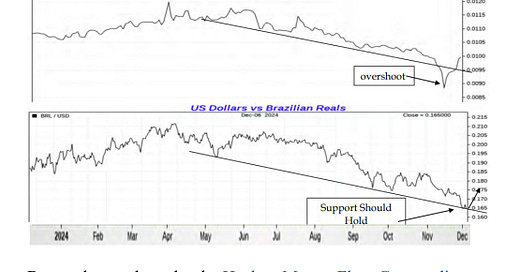The US dollar spike after the Trump’s election victory causedthe US dollar exchange rate to spike +8% higher. That shock caused currencies of developing nations, like Russia and Brazil,to tank by -30% and food inflation to spike by at least +30% higher.
Three days after Trump’s victory, China was forced to launch a $1.4 trillion bailout to save local banks. Syria as one of the poorest nations on the planet, saw food prices spike over +50% higher and its government get overrun by Jihadis in just 11 days.
But as shown above by the Hackett Money Flow Commodity Report, the “Trump Trade” of going long the dollar and stocks,and short US Treasury bonds, is already beginning to unwind as investors realize Trump will not be allowed to promote his agenda without substantial political resistance and mayhem.
As a result, fundamental climatic forces are again heralding the risk of global crop failures in the world’s 5 major grain growing nations including the United States, Ukraine, Russia, Northern Brazil and Argentina.
The United States is in transition from El Nino to La Nina that often causes the type of very cold and dry Mid-West weather called a Polar Vortex that is very destructive across the Mid-West wheat, corn and soybean belt. The current North American pattern favors above normal temperatures from Alaska across Western Canada and the Western US. That willpush down temperatures and threaten a sustained Mid-West crop “winterkill.”
Russia and Ukraine are suffering from drought and war. USDA estimate of Ukraine’s wheat production for 2024 is 22.5 million metric tons. Although up slightly from last year, that was down 16 percent relative to the 5-year average due to 26 percent reduction in planted acreage.
Due to severe drought conditions, Russia's 2024-25 grain harvest was just slashed to 124.5 million metric tons, down from a record 158 million tons harvested in 2022.
A La Nina Modoki event through December 22 portents record heat and low soil moisture in the Northern Brazil and Central Argentina grain belts, coupled with the second highest rainfall in history causing severe damage to South Brazil soybean crop.
The United Nations found in 2023 that nearly 282 million people, or 21.5 percent of the population in 59 analyzed countries/territories, faced high levels of acute food insecurity requiring urgent food and livelihood assistance.
By every measure, the 2024 harvest will be down by more than 15% in the world’s 5 major grain growing nations including the United States, Ukraine, Russia, Northern Brazil and Argentina.




